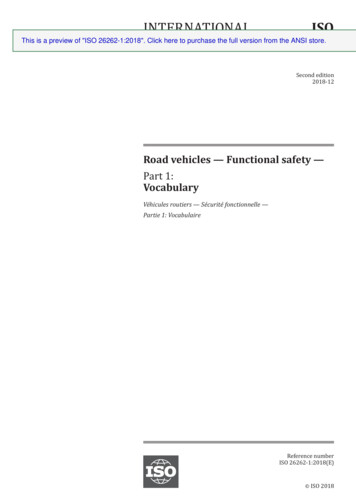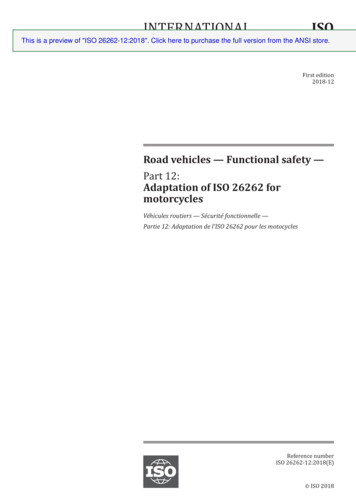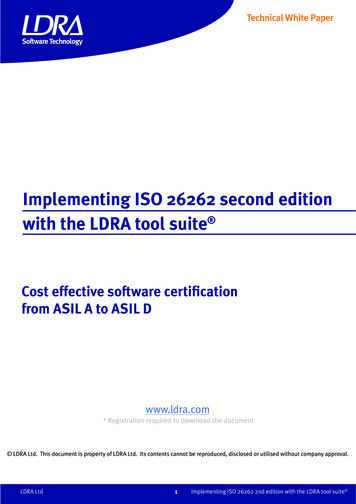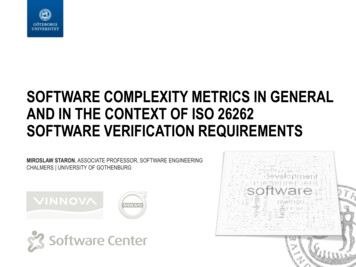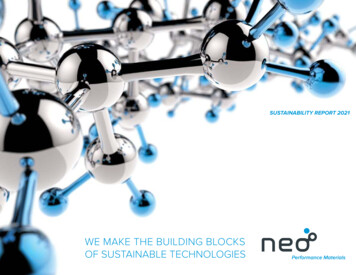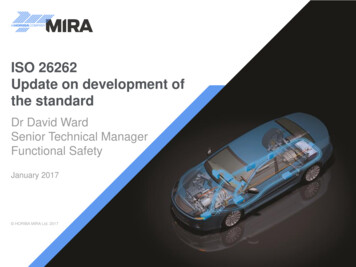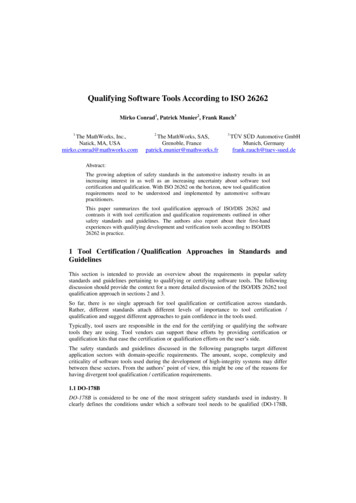
Transcription
Developing high-quality software is tough. ECLAIR is designed tohelp development, QA, and safety teams reach their quality goals.Coverage of ISO 262621 Introduction to ISO 26262:2018ISO 26262:2018, “Road vehicles — Functional safety,” is a series of international functional-safetystandards for the automotive industry. It adapts the IEC 61508 series of standards [6] to the functionalsafety of electrical and/or electronic systems within road vehicles. The first edition of ISO 26262 waspublished in 2011. The second edition, published in 2018, completely supersedes the previous versions,incorporates a general restructuring of all parts for improved clarity, and contains numerous changes,updates and extensions, among which: requirements for motorcycles, trucks, buses, trailers and semi-trailers; extension of the vocabulary; more detailed objectives and objective oriented confirmation measures; management of safety anomalies; references to cybersecurity; guidance on model based development and software safety analysis; guidance on fault tolerance, safety-related special characteristics and software tools.ISO 26262 provides guidance for the production of all software embedded into automotive systems andequipment, whether or not they are safety critical. ISO 26262 approach to risk management is based onthe determination of the Automotive Safety Integrity Level (ASIL) for each safety function assigned toeach subsystem. There are four ASILs: A, B, C and D, with A being the lowest safety integrity leveland D being the highest. ASIL D represents likely potential for severely life-threatening or fatal injuryin the event of a malfunction and requires the highest level of assurance that the dependent safety goalsare sufficient and have been achieved.In order to determine the ASIL of a safety function, the risk of functional defects has to be evaluated,for each hazardous event, according to three attributes:Copyright 2010–2022 BUGSENG srl. All rights reserved. ECLAIR Software Verification Platform is a registeredtrademark of BUGSENG srl. All other trademarks and copyrights are the property of their respective owners. This documentis subject to change without notice. Last modification: Fri, 1 Apr 2022 13:17:16 0200.1
exposure a classification of the probability of the hazardous event (from “incredible” to “high probability”);severity a classification of its impact on safety (from “No injuries” to “Life-threatening injuries (survival uncertain), fatal injuries”);controllability a classification of the possibility of the driver and other persons involved in the event,to deal with it (from “Controllable in general” to “Difficult to control or uncontrollable”).The combination of these attributes determines the ASIL, or that the function is not safety related andthus that there are no requirements to comply with ISO 26262, in which case it is assigned class QM(Quality Management).ISO 26262 is constituted by 12 parts, which are organized and structured as shown in the followingfigure:Overview of the ISO 26262 series of standards1.1 Role of ECLAIR in Ensuring Compliance with ISO 26262:2018The ECLAIR Software Verification Platform can be used to comply with several of the objectives ofISO 26262:2018 Part 6 “Product development at the software level” [8] and Part 9 “Automotive safetyintegrity level (ASIL)-oriented and safety-oriented analyses” [10]. In addition, the ECLAIR Fusa Pack,the ECLAIR Qualification Kits, and the ECLAIR Qualification Service, greatly simplify compliancewith the prescription of Section 11 “Confidence in the use of software tools” of ISO 26262:2018 Part 8“Supporting processes” [9].2
2 ECLAIR Coverage of ISO 26262:2018 Part 6 ObjectivesFor automotive applications, Part 6 of ISO 26262:2018 specifies the requirements for product development at the software level [8]. In particular it includes: general topics for product development at the software level; specification of the software safety requirements; software architectural design; software unit design and implementation; software unit verification; software integration and verification; and testing of the embedded software.ISO 26262:2018 Part 6 features several tables defining topics and methods that must be considered inorder to comply with the standard. The different topics and methods listed in each table contribute to thelevel of confidence in achieving compliance with the corresponding requirement. Topics and methodsare listed in each table either as consecutive entries, numbered with 1, 2, 3, . . . in the leftmost tablecolumn, or as alternative entries, labeled with 1a, 1b, 1c, . . . in the same column.The degree of recommendation to use each topic and method depends on the ASIL, and is symbolicallyencoded as follows: indicates that the method is highly recommended for the identified ASIL; indicates that the method is recommended for the identified ASIL;o indicates that the method has no recommendation for or against its usage for the identified ASIL.For consecutive entries, all listed as highly recommended and recommended topics and methods, inaccordance with the ASIL, do apply. For alternative entries, an appropriate combination of topics andmethods shall be applied in accordance with the ASIL indicated, independent of whether they are listedin the table or not. If methods are listed with different degrees of recommendation for an ASIL, themethods with the higher recommendation should be preferred. A rationale shall be given that the selectedcombination of methods complies with the corresponding requirement.The following tables have been obtained by extending the corresponding tables in ISO 26262:2018Part 6 with a column indicating where ECLAIR, suitably instantiated with the appropriate package,can be used to ensure compliance or to facilitate the achievement of compliance. Note that, in thesequel, every reference to MISRA C:2012 should be interpreted as referring to [11] as amended by [12],whereas MISRA C is [13]. As ECLAIR provides direct support for MISRA guidelines as well asguidelines from other coding standards, a reference for a guideline should be taken as a reference tothe corresponding ECLAIR service as described in the ECLAIR User’s Manual. For example, “MISRAC:2012 Directive 3.1” corresponds to the ECLAIR service MC3R1.D3.1 and “BARR-C:2018 Rule4.1.a” corresponds to the ECLAIR service NC3.4.1.a. For ECLAIR services that do not correspondto published coding standards, the service name is given in teletype font: for example, B.PROJORG isthe name of an ECLAIR service that supports automatically enforcing software architectural constraints.A complete definition of all ECLAIR services is contained in the ECLAIR User’s Manual and, whereapplicable, in the corresponding coding standard documentation referenced therein.2.1 MISRA C:2012MISRA C:2012 [11] with Amendment 2 [12] is the latest software development C subset developed byMISRA, which is now a de facto standard for safety-, life-, security-, and mission-critical embedded3
applications in many industries, including of course the automotive industry where MISRA was born.MISRA C:2012 Amendment 2 allows coding MISRA-compliant applications in subsets of C11 and C18,in addition to C90 and C99. MISRA C:2012 is supported by the ECLAIR package called “MC3”.2.2 MISRA C :2008MISRA C :2008 [13] is the software development C subset developed by MISRA for the motorindustry, which is now a de facto standard for safety-, life-, and mission-critical embedded applicationsalso in many other industries. It is currently undergoing a quite deep revision: the structure is beingmade similar to that in MISRA C:2012, support is being added for C 17, and (some of) the AUTOSARguidelines are being merged. MISRA C :2008 is supported by the ECLAIR package called “MP1”.2.3 BARR-C:2018The Barr Group’s Embedded C Coding Standard, BARR-C:2018 [4], is, for coding standards usedby the embedded system industry, second only in popularity to MISRA C. BARR-C:2018 guidelinesinclude 64 guidelines dealing with language subsetting and project management as well as 79 guidelinesconcerning programming style. For projects in which a MISRA compliance requirement is not (yet)present, the adoption of BARR-C:2018 is a major improvement with respect to the situation whereno coding standards and no static analysis are used. The adoption of the stylistic subset of BARRC:2018 (79 out of 143 rules) can be part of complying with the MISRA requirement that a consistentprogramming style is adopted and systematically used as part of the software development process.Moreover, complying with BARR-C:2018, besides avoiding many dangerous bugs, entails compliancewith a non-negligible subset of MISRA C:2012 [3]. ECLAIR support for BARR-C:2018 has no equalson the market: it is included in all ECLAIR packages, including the affordable package “B”.2.4 HIS and Other Source Code MetricsSource code metrics are recognized by many software process standards (and from MISRA) as providingan objective foundation to efficient project and quality management. One of the most well known set ofmetrics has been defined by HIS (Herstellerinitiative Software, an interest group set up by Audi, BMW,Daimler, Porsche and Volkswagen).The HIS source code metrics [5], while well established, include some metrics that are obsolete andmiss others that are required or recommended by software process standards, such as those that allowestimating function coupling. For this reason, ECLAIR supplements HIS source code metrics withnumerous other metrics that allow software quality to be assessed in terms of complexity, testability,readability, maintainability and so forth. Keeping track of these metrics also provides an effective andobjective method to assess the quality of the software development process. The full set of metrics isavailable in all ECLAIR packages.2.5 ISO 26262:2018 Freedom from Interference, Independence, and InterferenceISO 26262:2018 defines freedom from interference (FFI) as “absence of cascading failures between twoor more elements that could lead to the violation of a safety requirement” [7, Clause 3.65]. Simply put, acascading failure (CF) is a failure that causes an element to fail, which in turn causes a failure in anotherelement [7, Clause 3.17], whereas a common cause failure (CCF) is the failure of two or more elementsresulting directly from a single specific event (root cause) [7, Clause 3.18]. The union of CFs and CCFsgives what ISO 26262:2018 calls dependent failures (DFs), namely, failures that are not statisticallyindependent [7, Clause 3.29].The notion of DF comes into play in the definition of one aspect of independence: “absence of dependentfailures between two or more elements that could lead to the violation of a safety requirement” [7,4
Table 1 — Topics to be covered by modelling and coding nt of low complexityUse of language subsetsEnforcement of strong typingUse of defensive implementation techniquesUse of well-trusted design principlesUse of unambiguous graphical representationUse of style guidesUse of naming conventionsConcurrency aspectsA ASILBC D ECLAIRXaXbXcXdXe–XfXg–HIS [5] and other metrics related to program complexity. ECLAIR allows associatingthresholds to each metric.MISRA C/C and BARR-C:2018 define language subsets where the potential ofcommitting possibly dangerous mistakes is reduced.MISRA C/C enforce strong typing on the respective languages. E.g., forMISRA C:2012, Rules 10.1–10.8, 11.1–11.9, and 14.4.The MISRA C/C guidelines promote the use of several defensive programmingtechniques. E.g., for MISRA C:2012, Directives 4.1, 4.7, 4.11 and 4.14, Rules 2.1–2.7, 14.2, 15.7, 16.4, and 17.7.The MISRA C/C guidelines and thresholds on HIS metrics embody well-trusteddesign principles.More than half of the guidelines in BARR-C:2018 [4] concern coding style [2].MISRA C:2012 Rules 7.3 and 16.5 are also stylistic.The MISRA C/C guidelines provide some minimal naming advice. E.g., forMISRA C:2012, Directives 4.5 and 4.6, Rules 8.3 and 20.2. More extensive namingadvice is included in BARR-C:2018: Rules 4.1.a–d concern module and file names;Rules 5.1.a–c concern type names; Rules 6.1.e–i, 6.4.a and 6.5.b concern functionnames; Rules 7.1.e–o concern variable names. Two naming rules are also containedin AUTOSAR-C:2009 [1]. In addition, ECLAIR provides configurable naming rulesfor maximum flexibility.5
Table 3 — Principles for software architectural designMethods1a1b1c1d1e1f1g1h1iabcdeAppropriate hierarchical structure of software componentsRestricted size and complexity of software componentsRestricted size of interfacesStrong cohesion within each software componentLoose coupling between software componentsAppropriate scheduling propertiesRestricted use of interruptsAppropriate spatial isolation of the software componentsAppropriate management of shared resourcesA ASILBC D IR provides service B.PROJORG to enforce constraints about layering and to prevent bypassing of software interfaces.HIS and other metrics related to the size and complexity of software components. ECLAIR allowsassociating thresholds to each metric.HIS metrics counting function parameters and MISRA C/C guidelines on reduction of variables’ scope.ECLAIR specific metric B.STFCO UNIT allows imposing constraints related to cohesion withinand coupling between software components.Management of shared resources is addressed by some MISRA C/C guidelines and ECLAIRBug Finder checks. E.g., for MISRA C:2012, Rules 22.1–22.10.Table 4 — Methods for the verification of the software architectural designaECLAIRWalk-through of the designInspection of the designSimulation of dynamic behaviour of the designPrototype generationFormal verificationControl flow analysisData flow analysisScheduling analysisA oo ASILBC o o o Do ECLAIRXaXa–––XbXc–ECLAIR analyses of the implemented designs can highlight design defects and facilitate walk-through and inspection.ECLAIR builds accurate control flow graphs to reason on (feasible and unfeasible)execution paths.ECLAIR performs a number of data flow analyses to reason about, e.g., pointers, values, and dead stores.6
Table 6 — Design principles for software unit design and jOne entry and one exit point in subprograms and functionsNo dynamic objects or variables, or else online test duringtheir creationInitialization of variablesNo multiple use of variable namesAvoid global variables or else justify their usageLimited use of pointersNo implicit type conversionsNo hidden data flow or control flowNo unconditional jumpsNo recursionsA ASILBC D ECLAIRXaXbXcXdXeXfXgXhXiXjMISRA C:2012 Rule 15.5, MISRA C Rule 6-6-5 require subprograms to have a single entry anda single exit only. An upper threshold on metric HIS.RETURN allows for a more flexible approach.The MISRA C/C guidelines include prescriptions limiting the use of dynamic memory allocation.E.g., for MISRA C:2012, Directive 4.12 and Rules 18.7, 21.3, 22.1 and 22.2.The MISRA C/C guidelines include rules mandating the proper initialization of variables. E.g.,for MISRA C:2012, Rules 9.1–9.5.The MISRA C/C guidelines include prescriptions against the multiple use of variable names.E.g., for MISRA C:2012, Rules 5.3, 5.5–5.9 and 21.2.The MISRA C/C guidelines include prescriptions against the use of unnecessary global variables.E.g., for MISRA C:2012, Rules 8.7 and 8.9. The specific ECLAIR service B.GLOBALVAR allowsfine control of acceptable global variables.The MISRA C/C guidelines include rules restricting the use of pointers. E.g., for MISRA C:2012,Rules 8.13, 11.1–11.8, and 18.1–18.5. The specific ECLAIR services B.PTRDECL and B.PTRUSEallow fine control of pointers’ use.The MISRA C/C guidelines include several rules restricting the use of implicit conversions. E.g.,for MISRA C:2012, Rules 10.1, 10.3, 10.4, 10.6, 10.7, 11.1, 11.2, 11.4, 11.5, and 11.9.The MISRA C/C guidelines include prescriptions about hidden control flow and data flow. E.g.,for MISRA C:2012, Directive 4.9, Rules 2.1, 5.3, 13.2, 15.1–15.7, 16.3, 20.7, 20.9, and 21.4.The MISRA C/C guidelines include limits on the use of non-structured control-flow constructsas well as other unconditional jumps. E.g., for MISRA C:2012, Rules 14.3, 15.1–15.4, and 21.4. Athreshold on metric HIS.GOTO allows limiting the use of goto.MISRA C Rule 17.2 and MISRA C Rule 7-5-4 forbid recursion. A threshold on metricHIS.ap cg cycle also allows ruling out recursion.7
Table 7 — Methods for software unit mal verificationFormal verificationControl flow analysisData flow analysisStatic code analysisStatic analyses based on abstract interpretationRequirements-based testInterface testFault injection testResource usage evaluationBack-to-back comparison test between model and code, ifapplicableA o ASILBC o o Do e to the MISRA C/C and the BARR-C:2018 guidelines greatly increases code readability and understandability, thereby facilitating verification activities by walk-through, pairprogramming and inspection.ECLAIR implements numerous verification algorithms based on semi-formal notation.ECLAIR builds accurate control flow graphs to reason on (feasible and unfeasible) execution paths.ECLAIR performs a number of data flow analyses to reason about, e.g., pointers, values and deadstores.All ECLAIR verification algorithms are based on static code analysis.Several verification algorithms implemented by ECLAIR are formalized in terms of abstract interpretation.ECLAIR service for MISRA C:2012 Directive 3.1 facilitates ensuring that all code is traceable todocumented requirements, including safety requirements.Table 10 — Methods for verification of software based testInterface testFault injection testResource usage evaluationBack-to-back comparison test between model and code, ifapplicableVerification of control and data flowStatic code analysisStatic analyses based on abstract interpretationA ASILBC D ECLAIR–––––XaXbXcECLAIR executes a number of control flow and data flow analyses.All ECLAIR verification algorithms are based on static code analysis.Several verification algorithms implemented by ECLAIR are formalized in terms of abstract interpretation.8
Clause 3.78].1 As CFs are a subset of DFs, FFI is instrumental in achieving independence. In turn,achievement of independence or freedom from interference between the software architectural elementscan be required because of:a. the application of an ASIL decomposition at the software level;b. the implementation of software safety requirements;2 orc. required coexistence of the software architectural elements [8, Annex E].Concerning the last point, criteria for coexistence of elements are given in [10, Clause 6]. When coexistence is required there are two options: (1) all coexisting sub-elements are developed in accordanceto the highest ASIL applicable to the sub-elements; (2) the guidance provided in [10, Clause 6] is usedto determine whether sub-elements with different ASILs can coexist within the same element. Suchguidance is based on the analysis of interference of each sub-element with other sub-elements: evidencehas to be provided to the effect that there are no CFs from a sub-element with no ASIL assigned (QM),or a lower ASIL assigned, to a sub-element with a higher ASIL assigned, such that these CFs lead to theviolation of a safety requirement of the element.3Software partitioning is one of the possibilities for implementing freedom of interference, which mustbe developed and evaluated taking into account faults concerning timing and execution, memory, andexchange of information [8, Annex D]. ISO 26262:2018 prescribes that software partitioning must besupported, for ASIL D, by dedicated hardware features or equivalent [8, Clause 7.4.9]. A memoryprotection unit (MPU) is typically used for this purpose; however, as these devices can only enforcepartitioning of memory areas and system-on-chip peripherals, other measures are required in order toensure freedom of interference.ECLAIR Support for Freedom from Interference, Independence, and InterferenceECLAIR can be used to provide evidence ensuring freedom of interference, independence, and absenceof interference as follows:MISRA compliance: Compliance with the MISRA guidelines reduces the risk of execution blockingdue to unexpected excessive loop iterations (one of the issues in the timing and execution category)as well as of stack overflow (in the memory category).B.PROJORG: This is a very general ECLAIR service to detect and check, by control and data flowstatic analyses, all interactions between user-defined software elements occurring via read or writeaccesses to shared memory, function calls, passing and returning of data, as well as static dependencies due to header file inclusion and macro expansion.The B.PROJORG service can be used:1. In the context of ASIL decomposition applied at the software level, to verify whether the elementsimplementing the decomposed requirements are sufficiently independent.2. In the implementation of software safety requirements that rely on freedom from interference orsufficient independence between software components.3. To determine whether sub-elements with different ASILs can coexist within the same element byverifying absence of interference between the sub-elements.1This is the technical aspect of independence, the other aspect being the organizational one.E.g., to provide evidence for the effectiveness of monitoring safety mechanisms by showing independence between themonitored element and the monitor.3It is important to realize that “absence of interference” and “freedom of interference” are distinct concepts inISO 26262:2018. The latter concept does not depend on ASILs or lack thereof, so that “freedom of interference” implies“absence of interference,” but not the other way around.29
For applications 1 and 2, the user configures the software components by specifying the program elements (functions, variables, . . . ) that are assumed to be private to each component or shared betweencomponents, as well as the allowed interactions between components. ECLAIR will produce a violationmessage for each unwanted interaction. For application 3, the user configures the ASIL (or QM) of thesub-elements, and the service will flag all program actions whereby a CF might exist from a sub-elementwith no ASIL assigned (QM), or a lower ASIL assigned, to a sub-element with a higher ASIL assigned.All this greatly simplifies the work to be done in order to ensure compliance with the objectives ofrelated to Clause 7 and Annex E of ISO 26262:2018 Part 6, and Clause 6 of ISO 26262:2018 Part 9.3 ECLAIR Coverage of ISO 26262:2018 Part 8 ObjectivesFor automotive applications, Part 8 of ISO 26262:2018 specifies the requirements for supporting processes [9, Section 11], including: the criteria to determine the required level of confidence in software tools; the means for the qualification of software tools, in order to create evidence that such tools aresuitable to be used to support the activities and tasks required by ISO 26262.The ECLAIR functionality described above is qualifiable at TCL3 confidence levelin compliance with ISO 26262:2018 Part 8. TÜV SÜD audited BUGSENG software development and quality assurance processes for ECLAIR, as well as the internal validation activities performed by BUGSENG on each ECLAIR release. Atthe end of its assessment, TÜV SÜD awarded BUGSENG the “Software Tool forSafety Related Development” Certificate no. Z10 116151 0001 Rev. 00, attestingthat the ECLAIR Software Verification Platform is suitable to be used in safetyrelated development projects according to ISO 26262:2018 for any ASIL; the requirements of the “Validation of the software tool in accordance with [ISO262628, Chapter] 11.4.9” and “Evaluation of the tool development process in accordance with [ISO26262-8, Chapter] 11.4.8” are fulfilled. The ECLAIR Fusa Packprovides all what is necessary to take advantage of this important certification.The ECLAIR Qualification Kits for ISO 26262 provide further help to safety teams in charge of qualifying ECLAIR for use in safety-related projects where the dependence on the tool operational environmenthas to be taken into account: the kits contain documents, test suites, procedures and automation facilitiesthat can be used by the customer to independently obtain all the required confidence-building evidence.BUGSENG also offers the ECLAIR Qualification Service, whereby qualified BUGSENG personnelundertakes almost all the qualification effort.ECLAIR is also instrumental in achieving compiler qualification by validation. This is a service offeredin cooperation with our partner Solid Sands b.v. as part of their Compiler Qualification Service. Incase the SuperTest compiler test and validation suite reveals defects in the compiler, compliance withPart 8 of ISO 26262:2018 requires appropriate mitigations to be defined and be systematically enforced.Common mitigations include:1. avoidance of the use of certain language constructs in certain contexts;2. use of a third party tool to supplement the diagnostic messages not provided by the compiler (e.g.,when exceeding translation limits or violating language constraints);3. avoidance of the use of certain compiler option combinations.ECLAIR supports all three kinds of mitigations:1. compliance with the MISRA guidelines excludes the use of several language constructs in certaincontexts, and the MISRA guidelines have been designed taking into account the fact that some10
language constructs are more likely to expose compiler defects than others;2. ECLAIR checkers for MISRA C:2012 Rule 1.1 and for MISRA C :2008 Rule MP1.1-0-1 provide suitable diagnostic message for all the violations of the applicable language standard, including the exceeding of translation limits;3. due to the way ECLAIR works (intercepting all calls to the compiler, linker, assembler and librarian), checks can be defined to ensure the unwanted compiler option combinations are not used.4 The Bigger PictureECLAIR is very flexible and highly configurable. It can support your software development workflowand environment, whatever they are.ECLAIR is fit for use in mission- and safety-critical software projects: it has been designed from theoutset to exclude configuration errors that would undermine the significance of the obtained results.ECLAIR is developed in a rigorous way and carefully checked with extensive internal test suites (tensof thousands of test cases) and industry-standard validation suites.ECLAIR is based on solid scientific research results and on the best practices of software development.ECLAIR’s unique features and BUGSENG’s strong commitment to the customer, allow for a smoothtransition to ECLAIR from any other tool.BUGSENG’s quality system has been certified by TÜV Italia (TÜV SÜD Group) to comply with therequirements of UNI EN ISO 9001:2015 for the “Design, development, maintenance and support oftools for software verification and validation” (IAF 33).BUGSENG is an Arm’s Functional Safety Partner. Arm’s Functional Safety Partnership Program promotes partners who can reliably support their customers with industry leading functional safety productsand services.For More InformationBUGSENG srlVia Marco dell’Arpa 8/BI-43121 Parma, ItalyEmail: info@bugseng.comWeb: http://bugseng.comTel.: 39 0521 461640no shortcuts,no compromises,no excuses:software verification done right11
References[1] AUTOSAR. Specification of C implementation rules. Technical report, AUTOSAR, December2009.[2] R. Bagnara, M. Barr, and P. M. Hill. BARR-C:2018 and MISRA C:2012: Synergy between thetwo most widely used C coding standards, 2020.[3] R. Bagnara, M. Barr, and P. M. Hill. BARR-C:2018 and MISRA C:2012 (with Amendment 2):Synergy between the two most widely used c coding standards. In DESIGN&ELEKTRONIK,editor, embedded world Conference 2021 DIGITAL — Proceedings, pages 378–391, Nuremberg,Germany, 2021. WEKA FACHMEDIEN, Richard-Reitzner-Allee 2, 85540 Haar, Germany.[4] M. Barr. BARR-C:2018 — Embedded C Coding Standard. Barr Group, www.barrgroup.com, 2018.[5] H. Kuder et al. HIS source code metrics. Technical Report HIS-SC-Metriken.1.3.1-e, Herstellerinitiative Software, April 2008. Version 1.3.1.[6] IEC. IEC 61508-1:2010: Functional Safety of Electrical/Electronic/Programmable ElectronicSafety-Related Systems. IEC, Geneva, Switzerland, April 2010.[7] ISO. ISO 26262:2018: Road Vehicles — Functional Safety — Part 1: Vocabulary. ISO, Geneva,Switzerland, December 2018.[8] ISO. ISO 26262:2018: Road Vehicles — Functional Safety — Part 6: Product development at thesoftware level. ISO, Geneva, Switzerland, December 2018.[9] ISO. ISO 26262:2018: Road Vehicles — Functional Safety — Part 8: Supporting processes. ISO,Geneva, Switzerland, December 2018.[10] ISO. ISO 26262:2018: Road Vehicles — Functional Safety — Part 9: Automotive safety integritylevel (ASIL)-oriented and safety-oriented analyses. ISO, Geneva, Switzerland, December 2018.[11] MISRA. MISRA C:2012 — Guidelines for the use of the C language critical systems. HORIBAMIRA Limited, Nuneaton, Warwickshire CV10 0TU, UK, February 2019. Third edition, firstrevision.[12] MISRA. MISRA C:2012 Amendment 2 — Updates for IS
Coverage of ISO 26262 1Introduction to ISO 26262:2018 ISO 26262:2018, "Road vehicles — Functional safety," is a series of international functional-safety standards for the automotive industry. It adapts the IEC 61508 series of standards [6] to the functional safety of electrical and/or electronic systems within road vehicles. The first .
